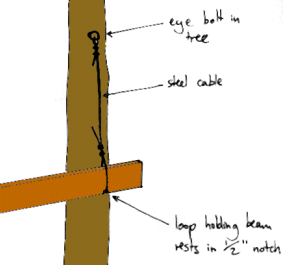Types of support | Flexible supports | Rigid framed supports | Fixtures and fastenings | Metal brackets | Cables
Knee braces | Dangerous things to avoid | Non-flat surfaces | Improving stability | Building without trees
Steel cables

Cables can be used in a wide range of support situations. They allow beams to be suspended to create floating attachments to the tree, they can be used to give extra support to long spans and they allow large overhangs to be supported without the need for unsightly and intrusive knee braces.
As shown in the diagram to the right, about 4 feet of cable is suspended from an eye bolt. It should never be wrapped around branches or parts of the trunk. The cable must not touch the tree at all or the bark will be worn away very quickly. The eye bolt must also enter the tree at right angles to the cable (as shown) so that the downward force is transmitted through the bolt as a shear force and the joint does not rely simply on the strength of the threads of the bolt.
When fitting your own cables, consult with someone who can give you quality advice on how to fit them so that you buy the correct parts for the load you need. Ask about Tree-Grips, they are a simple way of forming a loop at the end of a cable. A turnbuckle should be fitted to each cable you use. This allows you to adjust the tension correctly once the beam is in place. You may also need to tighten the cables every year or two and a turnbuckle is an easy way to do this.
Cables for static loads
Cables are a great way of supporting a long beam, an overhang or a radiating support treehouse because they can be very unobtrusive. However, think about how the fitted cable interacts with the design of your treehouse. It is simple enough to allow a cable to run along the inside of a wall if it supports a beam below, but avoid situations where cables run diagonally through open spaces as this will reduce your floor space. Would it be possible to run vertical cables up into the roof space, where they can then be diverted diagonally?
Cables for moving loads (flexible attachments to the tree)
Follow the same guidelines for static loads but remember to take precautions against moving parts hitting the tree. This is very harmful for the bark. The supported beam should rest 6"-8" away from the tree (as shown in the diagram above), with a small piece of wood fitted to the tree as a buffer in case the beam swings into it. The eyebolt must always fit into the tree at right angles to the direction of the cable so the weight is taken up as a shear force and not simply by the strength of the threads of the bolt.
